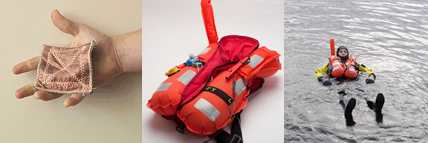ESA has provided research and development guidance to Finnish company Patria, with the help of Tampere University of Technology, in designing a search and rescue radio antenna that can be sewn into a life vest. Made from highly flexible, lightweight material that is robust against water exposure and moist conditions, and resistant to wear and tear, this special antenna has been designed for use by the Cospas-Sarsat worldwide search and rescue satellite system.
Cospas-Sarsat has been operating for almost 30 years and has helped to rescue more than 26 000 victims in distress. Sponsored by Canada, France, Russia and the United States, and started during the Cold War, the system operates 24 hours a day, 365 days a year, and aims to reduce the time required to alert rescue authorities in emergencies. Recent field trials with the antenna show that someone lost at sea wearing a life vest equipped with this new technology can be pinpointed within minutes. The Cospas-Sarsat system consists of emergency radio beacons carried by aircraft, ships or people, receivers on satellites, ground receiving stations, mission control centres and rescue coordination centers. When a carrier is in distress, the emergency beacon is activated. As satellites orbit the Earth, they ‘listen’ for active beacons and report their position to rescue authorities. This new antenna works as part of the Cospas-Sarsat distress transmitter.

This wearable antenna is able to send a signal to satellites using the Cospas-Sarsat worldwide search and rescue satellite system. It is made from highly flexible, lightweight material that is robust against water exposure and moist conditions, and resistant to wear and tear.
The life vest used to test the wearable search and rescue antenna. The vests were designed by Viking life saving equipment, based in Denmark.
The life vest with an incorporated search and rescue antenna being tested in a field trial in Finland.
Photo credits: ESA - J. Makinen, ESA - A. Le'Floch, P. de Maagt
Its high flexibility and small size make this antenna unique, given that the Cospas-Sarsat radio frequencies are so low. With such low frequencies, an antenna is usually much larger. “The fact that an antenna of such a small size could be created that operates at such low frequencies is quite an accomplishment,” said Peter de Maagt, ESA engineer. “This, and that the antenna works in the extreme conditions at sea, make this technology quite useful.” The life vests were designed by Viking life saving equipment, based in Denmark. In addition to integrating antennas into a life vest, a second attachable antenna is designed to be used with a diving vest.

